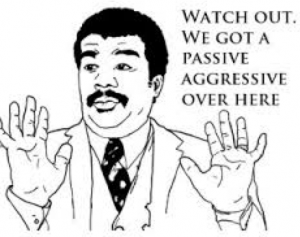We often teach coaching from the perspective of coaching to generational types, coaching to thinking types, coaching for difficult situations, coaching to give feedback, coaching to discover and build relationships – but recently we’ve explored the concept of coaching to behaviour types.
People love throwing around the words “Passive Aggressive”. But what does it actually mean? Is it just a style? Is it bad? What are the repercussions of this style?
What does a Passive-Aggressive (PA) look like?
I had used the term before, and thought it was a way of exerting an aggressive emotion or feeling, but doing it in a nice way. I never really saw it as a negative thing. In fact I often categorized it with the ever so typical Canadian “Sorry.” Someone bumps into me, and I say in that heartfelt Canadian accent “SOOrrry”. Am I just super nice and subservient? Or instead of telling someone they are are jerk for bumping into me, am I hoping that jerk will feel bad that I said sorry (unnecessarily) and actually apologize to ME?
First let’s describe what this type of behaviour is:
Passive Aggressive behaviour is typically categorized as someone who expresses negative emotions in a seemingly positive manner.
- Am I (or a member of my team) passive aggressive?
- Do they use sarcasm regularly as a means by which to express their dissatisfaction with others’ behaviour?
- Do they often agree to requests, yet less often fulfill their obligations? (ie. procrastinate, fail to deliver, sabotage efforts)
- Are they often forgetful, and use it as a scapegoat for fulfilling obligations? (i.e. often arriving late, losing items frequently, cancellations)
- Do they take offense and become defensive or angry when their behavior is pointed out, believing it was the other person’s fault?
- Do they use denial or evasive strategies when in challenging coaching discussions? (i.e. changing topics, using the obligations they forgot or procrastinated as a reason not to discuss the issue?)
- Do they often feign misunderstanding? Arguments turn into a matter of semantics rather than the real issue at hand? (i.e. “Oh you mean you wanted that done today? I had no idea, you didn’t SAY THAT!” .)
- Does their tone or behavior indicate anger, but their words say something completely different? (“I’m not mad!” – paired with distant or evasive behavior. This is the classic “Whatever” or “I’m fine” line that we toss around when we don’t want to get into a confrontation.)
If these sound familiar, you may have a passive-aggressive on your hands. People with this behavior dislike expressing emotions honestly or confronting situations. Often this cam be traced back to childhood where it may have been inappropriate to articulate dislikes and likes honestly. Instead they please the audience with their words in an affirmative way (this is the passive part) and add behaviours (usually non verbal ones, like facial expressions) that seem to conflict with their words (this is the aggressive part). This behavior is very confusing to recipients who are hearing one message, and witnessing or experiencing another one altogether. (Click to Tweet.)
Statement |
Passive Part |
Aggressive Part |
| “Whatever”. | This is fine, I’m not concerned. | Eye rolls and silent treatment to accompany the statement. |
| “I’m not mad”. | I am not angry with you. | I am mad, and I am not talking to you anymore as a result of it. |
| “You said that this was the MOST important thing to you. Now you are saying there are other important things as well?” | I am repeating what you said to me, indicating active listening and compliance with your demands. | Evading the discussion of the issue at hand, and focusing on an issue of semantics and clarity to defer and procrastinate from the issue at hand (prioritizing issues). |
While this behavior is sometimes categorized as abusive, controlling, and manipulative – we take the approach that this is a habitual learned behavior that the PA may not be aware they are exhibiting (or the impacts it may have on recipients). Also, PA’s are good at this – and they see success (namely not having to confront) so their inclination is to keep doing what they’re doing. If we use our kindness and curiosity we can identify their fears, insecurities, and concerns and create a safe environment to express their emotions directly.
4 Tips for Coaching to Passive Aggressive Personalities
- Point out the behaviour (be consistent). For example: You are telling me that you aren’t mad and I’m seeing you pull away. If you are angry let’s talk about why.
- Use contrasting statements (don’t/do) to indicate safety. For example: “I don’t want you to think that I am going to be angry with you for being honest. I do want us to be able to talk openly and build our relationship.”
- Ask open-ended questions. This is a classic coaching technique and the PA can often circumvent this line of questioning. If you can, think about possible reasons that the PA is upset, and test it out. “Are you scared that I am going to be angry with you? Tell me about that?”
- Stay Calm and go back to step 2. PA’s are masters of their skill. They are able to divert your attention to other issues causing the recipient to overreact. They may even exhibit pride in their ability to frustrate you. Stay calm and allay their fears and concerns.
Take the time this week to listen to yourself and others for passive aggressive behaviours. See if you can’t be more assertive (in a kind and curious way of course) without fear of confrontation. See if you can deal with a passive aggressive personality at work. Tell us about your success with it @whiteboardcons #betterfasterandlesspassiveaggressive.
Until Next Time,
Nicole

